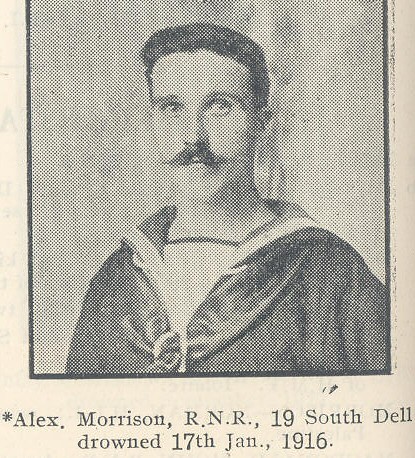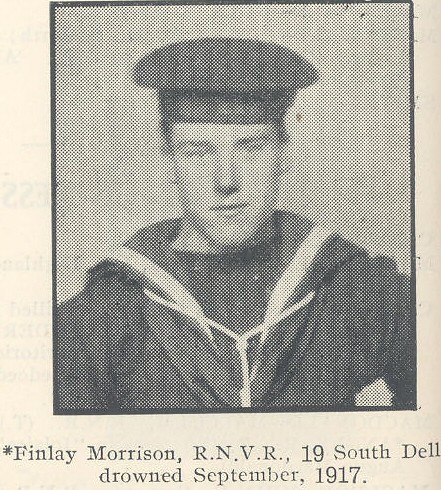The year 1918 is drawing to a close and Big Ben in London is about to
start striking the midnight hour. Six hundred miles to the north, HMY Iolaire is
ploughing her way north through the Minch, passing between Raasay,
Rona and the Scottish mainland. The weather, which had been reasonable
upon departure from Kyle, is turning increasingly windy. A heavy swell
is beginning to rise in response to the strong southerly wind. The
lighthouses, which serve as reference points for mariners in the Minch,
blink their messages to Iolaire. Milaid, on the rocky cliffs
near Kebock Head; Rona; Tiumpan Head on the eastern extremity of the
Point Peninsula; and Arnish, near the entrance to Stornoway Harbour.
In dozens of houses in Lewis, glasses are charged to the New Year. The last year of war is ending.
Dry
clothes are draped over beds, a stew is heating over the fire. In the
blackhouses in Ness, and the town houses of Stornoway. A kettle is at
the ready on the stove. A plate, cutlery and cups on the table. From
Eoropie to Brenish, from Lemreway to North Tolsta, and between Manor
Park and Newton, the same scene is repeated over and over. Only two
hours to go, the boat won't make Hogmanay. But it does not really
matter, the boys will be home soon.
The clock strikes midnight. It is 1919.
To be continued
Monday, 31 December 2012
94 years ago today
It is Hogmanay 1918, and the war has been over for seven weeks.
Survivors from the Western Front and the war at sea are flocking home.
As are hundreds of sailors from the Highlands and Islands of Scotland.
Three trains pull into the harbourside station at Kyle of Lochalsh, and
hundreds pour onto the platform and adjoining quayside to join a ferry
home. The Skye men can take the short hop to Kyleakin, or join the
steamer north to Portree. The sailors and soldiers from the Outer
Hebrides have a longer journey ahead of them.
The mailsteamer for Stornoway, the Sheila is alongside at Kyle, but it very rapidly becomes clear that she has nowhere near enough space to accommodate the hundreds that want to go home to Lewis and Harris. So, a cable is sent to the naval base at Stornoway, and Rear Admiral Boyle sends HMY Iolaire to Kyle to relieve the congestion. Iolaire, the former private steamyacht Amalthea arrives in the early evening, bumping into the pier as she docks.
A disorganised scramble occurs, where the throng of men divides between the Sheila and the Iolaire. No record is kept as to who goes on board which vessel. Some start off by boarding the Iolaire, then switch to the Sheila. Others do the reverse swap. Finally, at half past seven, Iolaire casts off and heads north. The Sheila follows suit in short order.
To be continued.
The mailsteamer for Stornoway, the Sheila is alongside at Kyle, but it very rapidly becomes clear that she has nowhere near enough space to accommodate the hundreds that want to go home to Lewis and Harris. So, a cable is sent to the naval base at Stornoway, and Rear Admiral Boyle sends HMY Iolaire to Kyle to relieve the congestion. Iolaire, the former private steamyacht Amalthea arrives in the early evening, bumping into the pier as she docks.
A disorganised scramble occurs, where the throng of men divides between the Sheila and the Iolaire. No record is kept as to who goes on board which vessel. Some start off by boarding the Iolaire, then switch to the Sheila. Others do the reverse swap. Finally, at half past seven, Iolaire casts off and heads north. The Sheila follows suit in short order.
To be continued.
Friday, 28 December 2012
Remembering Iolaire
As in the previous two years, this blog will carry a series of postings during the evening and night of 31st December 2012, going into the morning of 1st January 2013, commemorating the sinking of HMY Iolaire 94 years ago. The postings are timed to coincide with key events during the Iolaire's fateful journey, sinking and aftermath.
Website
Website
Thursday, 13 December 2012
Morrisons from 19 South Dell



During the First World War, three sons of Norman and Annie Morrison of 19, South Dell lost their lives whilst serving in the Royal Naval Reserve. A fourth son, John, served in the Ross Mountain Battery but survived the war. Norman is not listed in the Roll of Honour as having served during the Great War.
We find the five sons in the 1901 census at 30 South Dell with their mother Ann (then aged 48); their father appears not to have been at home on the night of 31st March / 1st April 1901. Listed are Angus (18), Catherine (15), Norman (9), Alexander (12), John (6) and Finlay (3).
Alexander was lost on 20 January 1917 (aged 29), when his ship, SS Bulgarian was torpedoed 50 miles west of Fastnet by U-boat U-84. He is remembered on the Naval Memorial at Chatham.
Finlay died on 22 August 1917 (aged 19), when his ship, HMT Sophron, was mined. He lies buried in the Seafield Cemetery at Edinburgh.
Angus was lost exactly a year later, on 20 January 1918 (aged 35) when his ship, the HMS Louvain, was torpedoed in the Aegean Sea by U-boat UC-22. He is remembered on the Naval Memorial at Chatham.
Tuesday, 11 December 2012
Coire Geurad
View Larger Map
Loch Coire Geurad, shown above, is one of many inland lochs in Lewis, located at the centre of the island. The nearest road is about 3 miles away to the north, as is the nearest permanent habitation. There was never any permanent dwelling houses here, but the Royal Commission on the Ancient and Historical Monuments of Scotland has listed 9 so-called sheiling huts at the northwestern corner of the loch. These ruins are designated as Gearraidh Coire Geurad. A sheiling is a place where people from elsewhere in the island would take their livestock in summer to fatten them up for winter.
In 1853, the site was described as consisting of 5 roofed huts. 120 years later, there were unroofed huts, one of which had three compartments.
I visited the southern end of Loch Coire Geurad in 2005 (the sheilings are at its northern extremity, on the southern slopes of Coltreasal Mor); just off the righthand edge of this picture.

Subscribe to:
Comments (Atom)